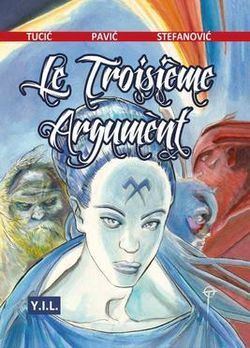Publication date 1995 | Artist Zoran Tucić | |
 | ||
Writers Milorad Pavić (stories), Zoran Stefanović (script) | ||
Say anything challenge ft the third argument
The Third Argument (Serbian: Treći argument) is a graphic novel based on the works of Serbian writer Milorad Pavić, with script by Zoran Stefanović and art by Zoran Tucić.
Contents
- Say anything challenge ft the third argument
- Creation and publication history
- Critical reception
- Awards
- The Third Argument in Pavis work
- References
Creation and publication history
The graphic novel has been created by artist Zoran Tucić and scriptwriter Zoran Stefanović based on motifs from Milorad Pavić's literature. Other artists have also participated in the creation of the novel: costume designer Jasmina Ignjatović (womens' costumes), painter and sculptor Jasna Nikolić (figure-concepts), art photographer Milinko Stefanović and graphic designer Rade Tovladijac.
The novel is based on Pavić's stories "The Wedgwood Tea Set", "Horses of St. Mark, or the Novel of Troy" and "The Third argument", as well as poems "The Game of Chess with Mexican Figures" and "The Novel of Troy". Three stories in the novel constitute the whole which addresses the "Balkan" and the "European Question" from historical, anthropological, psychological, mystical and political points of view – the prejudices, traumas and myths. The love romance hides the story of matter, historical events describe the abyss of time, and "the third argument" is the decisive one, not only for the fate of Europe, but the Humankind and civilization as well.
The graphic novel has been successfully received both by the public and critics in FR Yugoslavia. In 1995, the novel was published in Cyprus. Then it was introduced to the planetary public through the Heavy Metal Magazine, where it was published in sequels from 1998 to 2000. It 2016 it was published in France by YIL Editions, and republished ïn Serbia by Komiko.
Critical reception
The comic album was well received by critics in Serbia. Serbian writer and critic Pavle Zelić in a review wrote: "Authors have, in a very precise manner, touched the spirit, the essence of the oneiric, entangled and then disentangled style, which attracted so many readers to Pavić' prose." Journalist and critic Jelena Tasić wrote: "Done after the recipe of three colors – white, red and blue, stories themselves offer interpretation of their own spectrum, which as opposed to phrases of the enlightened, rational European thoughts on 'Liberté, égalité, fraternité', differ and come to persisting Balkan categories of future, present and past." Painter, poet and essayist Slobodan Škerović wrote about the comic: "Mystical charge is not allowing a reader/watcher to unleash imagination but it takes him to the realm where quiet buzzing of instruments of art overcomes the need for unquestionably solid form of ordered existence." He also wrote: "'Wedgwood's Tea Set' is a mythological quest for the meaning, told by a rich visual language and strict narrative suspense. The simulation surpasses the reality and completely compresses it into a decorative symbolism. This kind of inner emanation I only saw with Kurosawa, in Dodes'ka-den and Dreams." Journalist and writer Aleksandar Žikić wrote: "Coldness of colors is in accord with ethereal characters, who are more like symbols and using the rhythm of the prose sample."
The comic was also well received abroad. American comic book artist, writer and editor Archie Goodwin described the album as a "truly visually brilliant graphic novel". Polish critic Artur Dlugosz wrote: "A sensual comic 'Wedgwood's Tea Set' of the duo Tucić and Stefanović, attracts with its colors and execution technique. It is easy to get immersed into that wonderful story [...] Fluid storytelling takes us through new turnabouts of incredible love, describing the consequential attempts and heroically accepted defeats – as well as sudden punchline, which reveals a completely different side of story. If such comics could only be created in Poland..."
Awards
The Third Argument in Pavić's work
In a postmodern manner, the graphic novel is mentioned in Pavić's novel, The Writing Box (1999):
